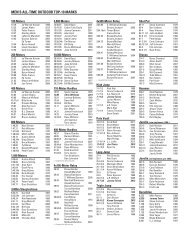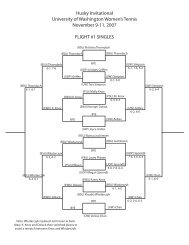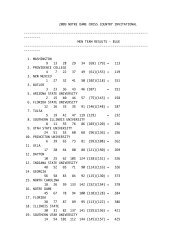HUSKIES Game Day #5 - GoHuskies.com
HUSKIES Game Day #5 - GoHuskies.com
HUSKIES Game Day #5 - GoHuskies.com
You also want an ePaper? Increase the reach of your titles
YUMPU automatically turns print PDFs into web optimized ePapers that Google loves.
Researchers at the<br />
University of Washington<br />
have learned that something<br />
most people take for<br />
granted is not true: that the<br />
force of fluids within the human<br />
body helps to break the adhesive<br />
bonds of invasive bacteria<br />
and counterbalance infection.<br />
Most scientists assume, for<br />
example, that a sneeze helps<br />
clear infection, or that urine<br />
helps to clear bacteria from the<br />
urinary tract.<br />
This may be true in some<br />
cases, but not in all. The presence<br />
of fluid force within the<br />
body, called shear stress, actually<br />
helps the bacteria that cause<br />
urinary tract infections, E. coli,<br />
to thrive. UW researchers have<br />
identified a mechanism by<br />
which the bacterial adhesion<br />
protein FimH can detect the<br />
presence of shear flow and<br />
“lock down” the bacteria on the<br />
surface being invaded. The protein,<br />
which acts as a nanometerscale<br />
mechanical switch, senses<br />
when the force is reduced, thus<br />
giving the bacteria a chance to<br />
scurry along safely.<br />
(A nanometer cannot be<br />
seen with the naked eye. It is<br />
one-thousandth of a micrometer;<br />
in <strong>com</strong>parison, a strand of<br />
human hair can be 50 to 100<br />
micrometers thick.)<br />
The simplest way to think of this is that<br />
some bacteria work like a “finger trap.” The<br />
harder you pull, the harder your fingers stick in<br />
the trap. The more you move your fingers<br />
together without force, the looser the trap.<br />
“E. coli has developed the ability to hold on<br />
tight only when the body fluid is trying to push<br />
it away. Just by using this finger trap-like mechanism,<br />
they’re sensing the strength and direction<br />
of the flow. Bacteria will resist high forces<br />
that threaten to remove them from the surface,<br />
but might move along with a weak ‘non-threatening’<br />
flow. In this way, they can move actually<br />
against the removing flow,” says Dr. Evgeni<br />
Sokurenko, research assistant professor of<br />
CAMPUS CORNER<br />
Fluid Forces Within the Human Body<br />
Actually Help Invasive Bacteria<br />
58 <strong>HUSKIES</strong> <strong>Game</strong>day<br />
A microphotograph of the cell protein FimH. The active site is green,<br />
and the force stretches the segment that connects to the rest of the<br />
bacteria, in pink.<br />
microbiology in the UW School of Medicine.<br />
The new findings also have significant medical<br />
implications. For example,<br />
• Urinary tract infection is the most <strong>com</strong>mon<br />
bacterial infection. It affects at least 7 million<br />
women a year in the United States and<br />
results ins more than a billion dollars in direct<br />
care costs.<br />
• Millions of people die each year through<br />
infections caused by bacteria settling on surfaces<br />
of biomedical implants and devices.<br />
“We need to know how bacterial adhesion is<br />
altered by shear,” says another author, Dr. Viola<br />
Vogel, director of the University of Washington’s<br />
Center for Nanotechnology in the Department of<br />
Bioengineering. “The most amazing<br />
part of this is that conventional<br />
wisdom says that bacteria have<br />
a more difficult time adhering to<br />
surfaces when they are subjected<br />
to shear force – whether the bacteria<br />
are in the intestines, in the<br />
urinary tract or in biomedical<br />
implants. This paper explains<br />
how bacteria firmly adhere to<br />
surfaces under shear flow, which<br />
is remarkable.”<br />
“Bacterial adhesion has been<br />
described for a century – bacteria<br />
need to adhere in order to<br />
colonize,” Sokurenko says. “It’s<br />
taken a century before we’ve<br />
been able to understand what<br />
happens once you see the bacteria<br />
clump red blood cells. What<br />
happens is that the bacteria and<br />
blood cells start to separate after<br />
you stop shaking. Then, if you<br />
shake them again, they clump<br />
again. The moment shear starts<br />
pushing them away from the surface,<br />
the bacteria adhere tightly. It<br />
demonstrates an amazing flexibility<br />
by infectious bacteria and provides<br />
a mechanism for bacteria to<br />
resist the effects of free-flowing<br />
inhibitor molecules that can<br />
block the adhesion.”<br />
In other words, E. coli<br />
appears designed to colonize<br />
parts of the body that are exposed<br />
to a lot of shear force. It has hairlike<br />
protrusions, fimbriae, (with<br />
the FimH protein on their tips) that touch the<br />
nearby surface, detect the dragging force, and<br />
set off a chain of molecular events that cause it<br />
to cling more effectively.<br />
Thomas and Vogel developed a structural<br />
model using steered molecular dynamic simulations<br />
describing how mechanical force switches<br />
the adhesion strength of FimH from low to high.<br />
“It’s quite remarkable, because this forceinduced<br />
switching is happening at the tip of fimbriae<br />
a long distance away from the cell membrane,”<br />
Thomas says. “It makes you wonder<br />
how many more proteins exist that are switched<br />
mechanically – that is a fascinating area for<br />
research.”

















